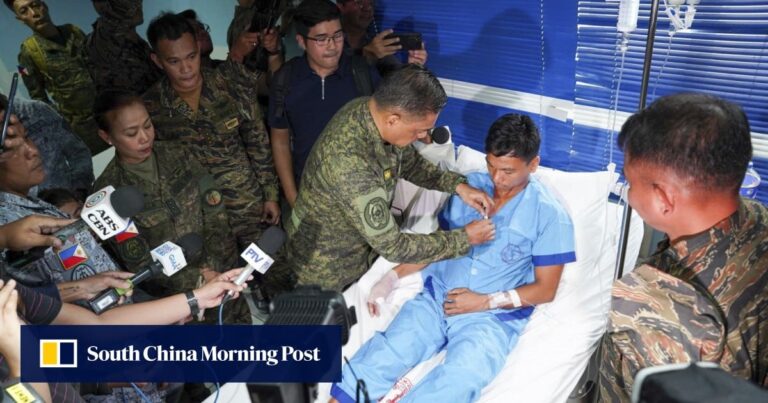Manila and Beijing have been at odds for months over territorial claims in the South China Sea, and on Monday a skirmish between the Philippine Navy and the Chinese coast guard left several Filipinos injured, including a sailor who lost a finger.
Philippine troops were on a resupply mission to the World War II battleship BRP Sierra Madre, which had run aground on Second Thomas Shoal, which was occupied by fellow troops in the hotbed of the area known as Ayungin Shoal in Manila and Ren’ai Shoal in Beijing, which both countries claim as part of their waters.

Carpio, who played a key role in the Philippines v. China case at the Permanent Court of Arbitration in The Hague that ruled in Manila’s favor in 2016, said the tribunal has no jurisdiction over military activities in the West Philippine Sea, the disputed part of the South China Sea within Manila’s exclusive economic zone. The Hague ruling found that China’s claims in the South China Sea, marked by the so-called nine-dash line, are illegal.
“My proposal is to change our presence from military to civilian. We will have a lighthouse run by the Coast Guard. The Coast Guard is civilian. We can have a Coast Guard substation…Let’s also have a research center,” Carpio told ABS-CBN radio.
China may try to block the construction of a civilian replacement for BRP Sierra Madre, but Manila could file a complaint with the arbitration tribunal and argue the structure has no military use.
Besides China and the Philippines, Malaysia, Brunei and Vietnam also have competing claims to the South China Sea.
The Philippine military blamed the Chinese coast guard for a “deliberate high-speed crash” into a Chinese vessel during a recent failed resupply mission, injuring crew members. Philippine military officials also reported that the Chinese had boarded their vessels and seized weapons and other equipment.
Carpio said the Chinese coast guard’s actions were “in violation of international law.”

“This happened within our exclusive economic zone. We have sovereign immunity. They cannot board, seize or capture our warships, including our auxiliary vessels,” he added.
Other options Manila could consider for its next resupply mission include using faster vessels and sending journalists to document instead of using knives to defuse tensions and counter false information that China may spread, Carpio said.
A Chinese takeover?
Political analyst Sherwin Ona, an associate professor of political science at De La Salle University in Manila, told This Week in Asia that Manila needs new ideas to deal with the conflict given China’s efforts to escalate tensions.
“I believe Judge Carpio’s position has merit in light of the UNCLOS and should be considered in conjunction with our strengthened military presence at Second Thomas Shoal,” Ona said, referring to the UNCLOS.
But China, a party to the United Nations Convention on the Law of the Sea, rejected the 2016 ruling, arguing it has jurisdiction over the waterway.
“I think we have to think now about worst-case scenarios, such as boarding the Sierra Madre or completely closing Second Thomas Shoal. I think this is a more pressing issue for our decision-makers,” Ona warned.
For Jose Antonio Custodio, a defense analyst and fellow at the Consortium of Indo-Pacific Scholars, Carpio’s proposal is long overdue action that should have been taken two decades ago when the Philippines was stranded on Sierra Madre island.
“The problem now is that it’s going to be even more difficult given China’s overwhelming presence in the region. For the Philippines to attempt to build, they need to have an equally strong presence in place to allow construction teams to approach and work unhindered by China,” Custodio told This Week in Asia.
“That did not happen because the Philippines was timid and afraid of China. Then, under the administration of the late former President Benigno Aquino Jr., the intention to improve was temporarily shelved due to arbitration cases. Then, under the Duterte administration, pro-China sentiment confounded Philippine policymakers,” he explained.
For the next resupply mission, Manila may ask Washington for logistical and intelligence support but should retain its primary responsibility of overseeing the garrison at Second Thomas Shoal, Custodio said.

Joshua Espeña, a security analyst and resident fellow at the Japan International Development Security Cooperation Agency, told This Week in Asia that he disagrees with Carpio because he believes it would rub salt into the wound by creating the impression that Manila’s efforts to remain hardline in the conflict have failed.
“This ‘withdrawal’ by replacing it with the PCG may make legal sense and therefore strategic sense, but it comes with operational and tactical costs that negate the strategic gains. You cannot build a lighthouse in the current situation where China is escalating its actions,” Espeña explained.
“Dangerous scenario [Chinese] Interception and confiscation would certainly punish the kind of switch proposed by Judge Carpio, which would make the deterrent unreliable. [Manila’s] It’s a demoralizer that China’s cognitive warfare operatives are already exploiting.”
Espeña said it was time for Manila to stand up for its rights and not play a part in China’s strategy to displace Filipinos in the West Philippine Sea.
“In this case, Manila needs the navy and coast guard to cooperate,” he said.
The Philippines has always pressed the United States for assistance, but the U.S. response has always been ambiguous in light of Philippine national interests, Espeña said.
“So the Philippines needs to ask the U.S. for assistance, including in terms of more patrol boats, but not necessarily activate the MDT,” he added.


